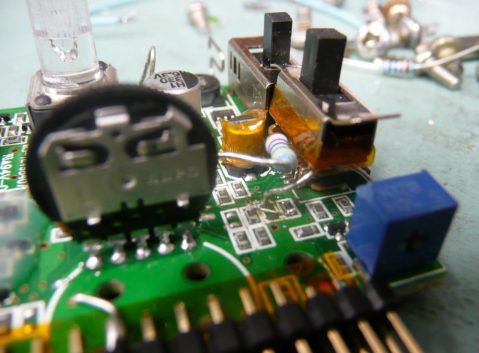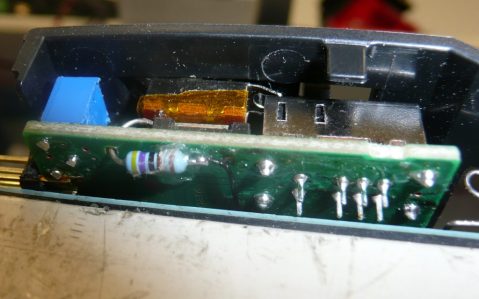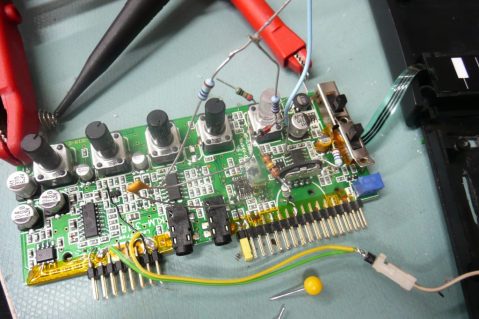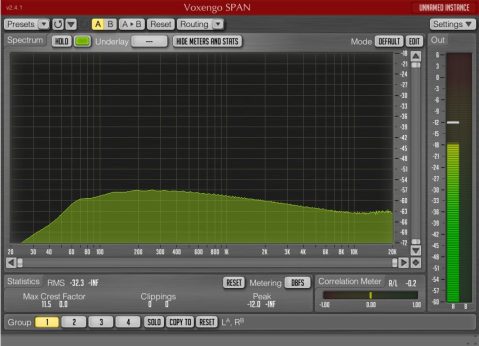Monotron Delay, a few mods more
Jes joo, moving on with the Monotron stuff. First up, certainly worth mentioning is this mod by Stexen, that another modder Dan wrote me about: Replace the keyboard potentiometer with a 500mm version!
Drop in a Spectra Symbol SoftPot such as this one, and the added precision should aid landing specific notes way better. I certainly am tempted to try this, but adding one would make my planned extender module grow in size too much. Thus, adding external CV/Gate control makes more sense at this point for me.. But then again, mounting this SoftPot to some additional box and wiring it to the pitch CV mixer through a series resistor might be one option.
On a completely different approach, adding this and turning the synth into some sort of a ‘mini-guitar’ might make a fun mod.
Other than that, I’m tired of typing ‘Monotron Delay’ all the time so I’ll start using the more convenient abbreviation ‘MD’ instead. With future scribblings in mind, whenever its this synth and the abbreviation, no I’m not talking about Sega Mega Drive ;)
LFO routing mod revisited
Since there have been requests about the details of this mod, I assume its best off described with a schematic. If you’re unable to add the mod even with the help of these additional descriptions, may I suggest you stick with a stock MD..
Like I suspected on my previous post, a 4k7 resistor proved a better alternative over a 10k one to interface the VCF CV summing mixer. If you add this mod to your MD, do test both alternatives to determine which one you prefer.
The way I ended up installing this mod was to first glue a small piece of pcb over the keyboard connector and then have the switch on top of that. Through-hole resistor and PCB feet leftovers are used to connect to the MD board. These help affixing the switch in place better than regular (flimsy) cable.

Side view of LFO routing switch. Stacked with a small piece of PCB on top of the keyboard cable connector.
One additional mounting suppor was to bend the lugs on both end of the switch. When the case top is installed, the downward pointing lug rests against the Power off/LFO shape select switch (SW1) and the upward pointing one against the slot in case top. Add this with the solder connections and together they form a mounting solution sturdy enough for the switch to withstand normal operation.
To add a possibility of resetting the LFO by external signal, I connected a 100k resistor to wiper of VR3A (LFO rate knob). Pulling the other end of this resistor to GND will reset the LFO. Didn’t bother testing whether connecting this to VCC would offset the reset to positive peak..
Triggerama
If you’ve been following my MD posts, you might recall from the first of them that I had the two unused inverter gates circled (section D3) in the schematic. What idea I came up for these was to test adding a Arp Odyssey style gate-to-trigger converter. Combining this with the LFO reset mod would allow using the MD keyboard to retrigger LFO. Additionally routing this through a switch would’ve allowed incorporating both free-run and retrig modes.
On the Arp Odyssey circuit, two NAND-gates Z1C and Z1D are configured as inverters and (if I got the following bit right), with a handful of support components, the combined propagation delay of these inverters is used to turn a incoming keyboard gate signal to a positive-going trigger pulse.
Too bad I didn’t get the circuit working fully: The trigger pulse was there but the output also had a DC voltage component I was unable to remove. Whilst testing variations in the circuit, I managed to break yet another solder pad on the PCB. This lead me to decide that it’s maybe better to back away gracefully, repair whats broken and not waste time possibly inflicting more damage. Seems the pads are easier-than-average to break with repeated soldering..
In general, if you wish to play around with these unused inverter gates, bending up at least pins 1 and 13 from IC3 is required. Depends on the intended use, of course. If you’re not comfortable with the idea, alternative approach would be to buy a replacement chip, cut away the existing one from MD PCB, and bend the pins up on the replacement prior to soldering that to the board.
Op-amp upgrade
One thing that bothered me from the get-go with MD was the high freq noise on the output. To illustrate this here’s a spectral analysis of single (lowest) note:

FFT freq plot of stock Delay, lowest note held. Voxengo’s free Span VST for analysis.
As you can see, there are two very distinct spikes; first at 8kHz and second at 16kHz. I have no clue where these harmonics might originate, but as the above reads, they sure are well present.. Actually even louder than the actual body of the sound!
Where upgrading the audio path and op-amps are concerned, only IC4 needs to be swapped. The circuitry has been (conveniently) designed so that the other op-amp (IC2) does control / calibration related stuff only. For the replacement I chose MC33174.
I must admit I didn’t bother doing too much investigation into suitable replacements. Safe to say, there certainly should be other (better?) alternatives out there. It’s good to keep in mind that Monotrons use op-amps designed to be operated from a single-sided power supply and this rules out the most ‘classic’ op-amps, if you wish to retain ‘drop in replacement’
So initially comparing this with LM324 by spec, what raised my interest was that it has a better Common-Mode Rejection Ratio (100dB vs 80dB). Going for higher decibels, how scientific ;).. Anyhoo, pop in this alternative, and:
Spikes gone! Also both the low and high freq roll-off curves are affected, especially for the latter things look pretty interesting. Can’t say I notice much difference in noise floor. Maybe the synth just is noisy due to low operating voltage etc.
Internet suggested (hi Michael!) that the disappearance of spikes might have to do with MC33174 having a higher bandwidth and slew rate, but the datasheet I have for LM324 doesn’t list the latter. Bandwidths are 1.8MHz and 1MHz, respectively.
In case you want to compare the audio files used for the above yourself, get the 44k/24bit wavs here: Original MD & MC33174 modded MD. Both are recorded by triggering the lowest note on the keyboard, but weirdly enough the tuning is slightly different.. Probably didn’t hit the keyboard spot on. RME Fireface 800 was used for the A/D conversion.
Bla-blabbage
Next up, I guess its time to see about that expander thingie. Must admit that the VCF FFT plots above make me want to modify the high-pass cutoff point (75Hz or so) to include lower freqs.. I’m guessing the cutoff freq has been set this way simply to lessen distortion on the internal speaker. As it is unable reproduce any real bass frequencies, cutting them off removes the good-for-nothing mechanical movement.
If you have any MD mods to share, do leave a comment! Links much appreciated. If anyone takes up the task of building the mini-guitar-thingie (with the SoftPot), I certainly want to be among the first to see it :)
49 responses to “Monotron Delay, a few mods more”
Trackbacks / Pingbacks
- - 23/12/2016










I must admit that lfo retriggering mod is what i was looking for! Cool. Ill try later :)
Hi, and thanks for your interesting articles about modding the Mondelay.
Mine has just arrived and there is one mod I’m particularly keen to carry out, but haven’t seen mentioned by you or anyone else, which is to change the routing so that the delay feedback doesn’t go back through the filter.
According to my reading of the schematic, the delay input is fed from the VCF, but in use it ends up sounding more like the VCF comes after the delay because VCF tweaks affect the whole sound, both initial signal and subsequent taps, and I think this is because the feedback goes back through the VCF. I’d much rather it fed straight back to the input of the delay, so that filter tweaks only affect the initial tap of the delay rather than subsequent ones.
I know very little about electronics (basic circuits, and I can solder ok) but this seems like it should be a fairly trivial mod. Any thoughts?
One downside I guess is that the feedback would no longer degrade over time the same way it does at the moment by being repeatedly passed through the filter/distortion circuit… but presumably it would still degrade a bit as it goes through the filter multiple times.
Check the PT2399 datasheet, the circuit used in MD is pretty mostly a direct copy from ‘echo application circuit’ with few modifications. What you need to do is to take the output signal from pin 15 of PT2399 and add few parts according to application circuit. To retain the feedback loop but exclude the VCF from it, you’d need to rewire the wiper of VR7A like in the PT2399 application schematic.
As for the degradation, the datasheet doesn’t really explain how the chip works internally so the following is just me guessing. In-circuit, the PT2399 sampling rate (== fck on pin5??) is clocked way past the intended spec when longest delay times are used. For this fck clock the datasheet lists 2Mhz which equals 342ms delay time, whereas on MD I measured around 576Hz for the longest delay. I’m thinking that the degradation has more to do with this, as clock/sample rate is really low and subsequent feedback pings get resampled (A -> D -> A conversion) in and out of the chip.
Here’s a zip archive containing some MD component datasheets (download and rename to .zip):
Click to access md_data.pdf
Do write a follow-up comment how did it go with the feedback modding, if you get around implementing that :)
Thanks for the reply and datasheets. Unfortunately my understanding of electronics is insufficient to be able to extrapolate what exactly I need to do from these :( I guess I was kinda hoping it would be simple enough to describe in terms like “cut X, and connect Y to Z” maybe with the odd resistor and/or capacitor thrown in. Was I being hopelessly naive?
So maybe I described it badly then ;).. What I’d try for this mod would be to remove R58 (10k), replace it with a through-hole version and bend its feet so that the junction of C20 & R58 can be connected to junction of R74 & R75 through the 10k resistor. This rewires the wiper of VR7A to somewhat match the PT2399 application note schematic, like I mentioned on my previous comment.
That’s exactly what I was after – thankyou! I will give it a go and let you know what happens :)
Speaking of the guitar-like monotron mod, that is exactly what I am trying to do. I’m a little weak on electrical engineering, but essentially I want to remove the small keyboard that is on the monotron and replace it with a longer ribbon controller.
So the keyboard on the monotron has three lines running into it, any chance you could do a little explain on how I would hook up my new ribbon?
Sure. The keyboard is just a potentiometer in disguise, so the three wires correspond to that of a regular potentiometer: wiper and both ends of the resistive track. Pin arrangement might vary between parts, so make sure to compare the pinout of your new part with the Monotron schematic.
Cheers. I just got my Duo in the mail today. Can’t wait to get cracking on it.
I really want to do this as well, and alas I too know very little about electrical engineering and such. Could you be a little more specific about how I would connect the 500mm softpot to the monotron board?
Check the comments of this post more closely, I explained this to Rion already. Do read up about potentiometers too, if this is all news :)
http://en.wikipedia.org/wiki/Potentiometer
I understand the potentiometer part. The problem is that when I look at the pics and specs of the 500mm softpot you linked to, it looks like the connector’s too big to fit into the connector that the monotron’s ribbon controller’s usually hooked into (not to mention the connectors are in a different order).
Basically, I’m wondering how exactly to connect the new softpot to the monotron board. Is there soldering involved? Sorry, I’ve hardly done this kind of stuff before, but I’m on a tight budget. I have to make do with the monotron instead of a bigger synth, but I’d still like to have the easier playability of a larger ribbon controller.
Ah ok.. Depending on the actual connector type of SoftPot (not sure what alternatives exist) you need to either install a matching mating connector or connect the part directly to the Monotron PCB. I’d recommend going for a mating connector (if you can fit it) as it makes replacing the ribbon a breeze. Unfortunately both methods require soldering.
If you need to practice soldering, damaged consumer electronics are excellent for the purpose :)
Hi,
I’m a huge fan of monotron line and I have a fb group with all the links I can collect and very interesting people doing some contributions. I will try to put these at standard webpage but meanwhile fb gives me the chance to collab and contribute…
I’m linking your nice articles to it and if anyone is interested on join, just search moDnotron at fb.
We will very happy to share all of our success!
Cheers,
Mutis
I’m not on FB, but when you get that site of yours up and running please leave the url link here on the comments.
thanks the the hints and mods!
here’s my Monotron Delay: https://www.youtube.com/watch?v=de8UbQJ3oMI
Hmm, one knob for resonance and the other one for ??
the other on was the internal trim pot, for the LFO Waveform ;)
What do you mean by a through hole part? Is that just simply a direct connection like a straight wire instead of a resistor? Sorry I’m fairly beginner…
I mean this http://en.wikipedia.org/wiki/Through-hole .. Instead of trimming the feet of a resistor short and using wires to connect to other parts, the feet become the link / connection. Far more reliable than wires too :)
“To add a possibility of resetting the LFO by external signal, I connected a 100k resistor to wiper of VR3A (LFO rate knob). Pulling the other end of this resistor to GND will reset the LFO. Didn’t bother testing whether connecting this to VCC would offset the reset to positive peak..”
I added a switch to change the LFO into a simple envelope generator. Does this mean that to use the LFO/EG and filter on another synth I would just need to add a resistor? No extra circuits?
Depends on the signal logic of your application. For the control signal, this resistor kludge is ‘active low’ without any extra circuits. If your application is ‘active high’ you need to add a inverter (eg. unused port from IC3). If your “another synth” outputs sth else than 5V, you also need to match the voltage levels.
I’m not sure if/how I’m actually going to develop this feature further, but at least the option is there if I decide to do so. Have quite a few other projects in the way before I can continue with this one.
hello well i’m not really good in electronic but i’m trying to find how to reset the Lfo with simple push button on monotron delay…could you help me for this???
thank you for your site!!!
Yeah, just connect your push button between the common point of C9+Q4+Q5 and VA (check schematic for locations). Connecting to GND should work too, though I’m not sure if adding some series resistor would be of good practice.
Hello thank you for your help, i will try to find it and i will tell you…
Hello i’m trying to find where i must connect my push button i see it on de schema but i didn’t find it on my monotron…Sorry for my missunderstanding….
Then sleep over it and look again! :) Use a multimeter set to resistance mode and poke through parts, checking for zero ohm readings.
thanks i’m searching…maybe i sleep too much!! ;-)
Hi there, I’m looking for some advice re LFO reset on the monoTRIBE. I see the suggestion here for the monotron delay – to GND the LFO rate wiper. Any idea if this would work with monotribe as well?
I’ve been looking for documentation of this mod on monotrons, but I think the site people were referring to has parted from this world.
If anyone has ideas or suggestions let me know.
Thanks.
And thanks Arto for your documentation here!
-C
my understanding is that the LFO is digitally generated, along with the EG in the monotribe. Not sure what this means re LFO reset. As far as I can tell, nobody has implemented midi control of LFO reset either.
No idea about this, sorry.
Korg has only released the drum section schematic so it’s impossible to compare the two without having both devices at hand. The Monotribe product page does mention that “Monotribe shares the monotron’s analog DNA”, which could be understood both using the same circuitry. Yet again this is something needing to be confirmed by comparing the actual circuit to the Monotron schematic (part types, trace connection measurements etc.).
I routed the LFO waveform to the delay time, and managed to get a pseudo modulation. It sounds cool, but it seems that the feedback is out of control most of the time unless you are careful with it… Do not know why that is…
I figured a delay time mod out. It is a bit rough, but it sounds bloody brilliant. Take the LFO output from the labelled pad and hook it to the rightmost pin of the TIME pot. You get modulated delay! Keep the filter completely open when using it though, otherwise you get some horrendous resonance and feedback…
Cool! Any chances of getting a demo of this mod online (eg. Youtube)? :)
I made a vid of it just for you! I included some more details about the mod too: https://www.youtube.com/watch?v=JmppP9i0Hmo
I apologize for the reposts. It took me a while to figure the cutoff thing out…
Hi , I would like to try replacing the op-amp as you suggested.One noobie question though , where is IC4 if Im looking at the pcb from the top? I dont read schematics well so Im wondering how to recognise IC4 by sight on the PCB? Its just that I dont want to accidentaly change out IC2 instead as i notice that its also an LM324… Many thanks for your page . Ive only tried the resonance mod so far and look forward to trying some of your mods soon.
Cheers
It’s the one next to the headphone out jack. You’re welcome :)
Do you reckon it would be possible to have the LFO control the cutoff as well as the pitch?
Sure! In its most basic form, you only need to omit the switch I used in the mod. However I do recommend including a switch (or switches) in order to control whether the LFO is routed only to pitch or cutoff or both. Having a fixed routing to both will limit your options sound programing wise.
There’s a bit more in writing about the mod under section “Wobble?” on this earlier post: https://amazingdiy.wordpress.com/2012/06/04/monotron-delay-a-few-mods/ .. but nothing there really that isn’t mentioned on this post as well :)
I really want to find a mod that gets rid of the noise floor so that I can use it as a decent delay insert with external (eurorack) gear…
I’m not that much on the amp about Eurorack specs, but the PSUs do have a +5VDC rail don’t they? I’m wondering here whether removing the DC/DC stepup converter and directly powering Monotron from the +5V rail, or off a separate linear DC/DC converter would remove any of the noise floor. Then again it’s not like the delay chip is much of a quality thing, its sound does get extremely dirty when the maximum specced delay time is exceeded. Iirc this limit is somewhere slightly above 300ms, didn’t bother pulling up a datasheet to check.. :)
Bypassing the stepup converter was one of the things I planned to have on my Monotron extender. Never got that far with my build as to test it, because the pin headers I chose to use proved mechanically too stiff to attach/detach the Monotron to the extender without breaking things.
Hey man, thanks for this. Ive been desparate to try and mod mine… to remove the dry signal completely. so that I can use it as a send/return echo box but only have the delayed signal audible. problem is, un modded, when i send to it, the dry signal is audible as well, which is unhelpful if you are trying to use it in the dub style. I don’t want to reinforce the dry signal.
Some told me I need to remove r58 or c20 and ‘take the output from there’
problem is, I cant find a labelled circuit diagram of the monotron delay, only there is one online for the Duo.
Help me Obie Wan…You’re my only hope…
You mean the schematic? I have a copy of it linked to one of my earlier posts about the synth.
If you want to have the echo feeding back within the synth, you definitely want to keep C20 and R58 in the circuit because removing either one will disable feedback altogether. If so I’d suggest taking wet signal from pin 14 of IC5 and running it through a 10µ electrolythic cap (like C26 on audio output). Perhaps add a opamp buffer in-between if you want to play it safe.
However if your plan is to use a separate audio mixer to create the feedback loop, then besides the above I’d suggest removing R79, soldering it to a switched jack connector and running wires to where R79 was. This would then create a true bypass if a cable is plugged in, effectively disconnecting the audio input of IC5 from the rest of the circuit. With the cable unplugged you could still use the synth in it’s stock config.
Hope this helps. All from top of my head and quickly looking at the schematic, so beware! :)
Hey man and thanks. I was hoping for an equivalent to this http://www.timstinchcombe.co.uk/synth/monotron_ref_des.jpg
but for the delay, so I know what is what.
I was hoping it would be as easy as decapitating one of the resistors there to just cut the dry signal out, but it sounds perhaps beyond my means.
I want it to feed back, just dont want it to play the unechoed dry signal through, which it currently does, if you get my drift. I just want 100% wet, so i can add it to the dry in my mixer. but I do want it to feedback internally, without me having to do the feedback loop externally. Its to use while djing really.
Yeah sadly there isn’t a layout diagram like that available. While I was modding my Delay, I used a multimeter to trace which part is which.
If you need a delay effect, how about a guitar pedal? Those are about as cheap as the Monotrons and likely the sound quality is better too :)
Thanks for posting these mods! I’m looking into upgrading the op-amp for my monotron delay. If those audio files are still floating around somewhere I’d love to hear them (the dropbox link is dead)
Hi Matthew, thanks for the heads up and sure I still have the files (links updated now).
All Dropbox links broke after they did some sort of on-site change and I’m updating old links based on requests, unfortunately don’t really have the time to start going through all posts currently. The whole blog could use a refresh (looks and all) for sure ;)